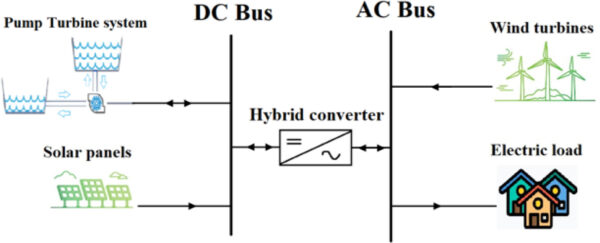Researchers from Morocco’s Rabat School of Mines have proposed building a hybrid PV and wind power plant in the eastern province of Zagorap that uses pumped hydro storage (PHS). Their proposal is based on a simulation studythat optimized the system size in economic and technical terms.
“We proposed this technology because the owners of the area do not greatly benefit from the seasonal groundwater that passes through the valley, despite the presence of a dam,” the group said. “Accordingly, we will exploit this water to generate energy and achieve energy self-sufficiency. By harnessing this underutilized resource, we aim to provide sustainable energy solutions and drive economic and social progress in the region.”
The system simulation was conducted through the HOMER software and was focused on the energy demand of three tribes in the village of Tazarine, namely Ait-Rebaa, Ait-Imnasef, and Ait-Baha, with 90 small houses, 30 large houses, six mosques, one village office, and two schools. In total, the average energy demand there is 1,050.92 kWh per day.
The village was found to have 188.67 kWh/m2 of solar radiation at its lowest in November, and the highest in March at 228.37 kWh/m2. The average temperature throughout the year is 20.82 C, and the wind speed averages 5.02 m/s. The clearance index is at its lowest in June and July when it scored 0.63, and at its highest in December, at 1.15.
“This hybrid system’s software optimized each scenario generated through the various micro-grid configurations to satisfy the village’s demand load at the lowest possible cost of energy,” said the academics. “The outcomes of the HOMER simulation and optimization procedures indicate that among the four scenarios, the system configurations were ranked from the most to the least economically profitable. The hybrid energy systems are classified as 1-PV/Wind/PHS, 2-PV/Wind, 3-PV/PHS, and 4-PV.”

Image: Ecole nationale supérieure des mines de Rabat,Cleaner Energy Systems, CC BY 4.0
Each scenario combined different sizes of PV, wind turbines, and PHS units. The solar modules were assumed to be monocrystalline panels of 350 W, with an efficiency of 18.04%, installed on a slope of 31 degrees. Each wind turbine had a rated power of 25 kW, and the PHS units were assumed to have a capacity of 245 kWh. This system could also import or export electricity from the grid and had a power converter of 20 kW.
While in scenario 1-PV/Wind/PHS, the system includes 101 kW of PV, four wind turbines, and one PHS unit, scenario 2-PV/Wind has 244 kW of PV, four wind turbines, and no storage. In the case of 3-PV/PHS, the system has a PV of 207 kW, no wind turbines, but three units of PHS. The 4-PV scenario includes only 1,478 kW of PV, with no wind turbines or storage at all.
The analysis showed that the system under the first scenario could achieve the lowest levelized cost of energy (LCOE) of $0.03831/kWh, while the second, third, and fourth scenarios achieved $0.058/kWh, $0.130/kWh, and $0.289/kWh, respectively.
“Regarding the Net Present Cost (NPC), the first scenario stands out as the optimal choice, with an NPC reaching approximately $262,596.2. Following closely is the second scenario, with an average NPC of approximately $408,232.00. While the third scenario trails behind with an average NPC of approximately $648,911.00. The fourth scenario stands out with a significant NPC, reaching approximately 1.47 million dollars,” the researchers said.
The operational and maintenance (O&M) costs for scenarios 1 to 4 were found to be $3,064, $4,448, $18,391, and $26,817, respectively. Capital costs were found to be $212,393, $329,647, $398,361, and $1.08 million, respectively. “Operating and maintenance costs are also minimized, while the system achieves an impressive 86% efficiency in energy consumption versus production,” the team added.
“In scenario 1, the combined energy generation, excess production, and electrical consumption amount to 613,145 kWh/year, 67,781 kWh/year, and 530,193 kWh/year, respectively,” it further explained. “Scenario 2 follows with about 883,247 kWh/year, 323,454 kWh/year, and 548,557 kWh/year. Progressing to scenario 3, the values are 503,794 kWh/year, 77,549 kWh/year, and 3,387,112 kWh/year. Lastly, scenario 4 registers a total of 2,859,21 kWh/year, 2,460,626 kWh/year, and 393,016 kWh/year, contingent on the pricing model.”
The scientists presented their findings in the paper “Optimization and design to catalyze sustainable energy in Morocco’s Eastern Sahara: A hybrid energy system of PV/Wind/PHS for rural electrification,” published in Cleaner Energy Systems.
This content is protected by copyright and may not be reused. If you want to cooperate with us and would like to reuse some of our content, please contact: editors@pv-magazine.com.



By submitting this form you agree to pv magazine using your data for the purposes of publishing your comment.
Your personal data will only be disclosed or otherwise transmitted to third parties for the purposes of spam filtering or if this is necessary for technical maintenance of the website. Any other transfer to third parties will not take place unless this is justified on the basis of applicable data protection regulations or if pv magazine is legally obliged to do so.
You may revoke this consent at any time with effect for the future, in which case your personal data will be deleted immediately. Otherwise, your data will be deleted if pv magazine has processed your request or the purpose of data storage is fulfilled.
Further information on data privacy can be found in our Data Protection Policy.